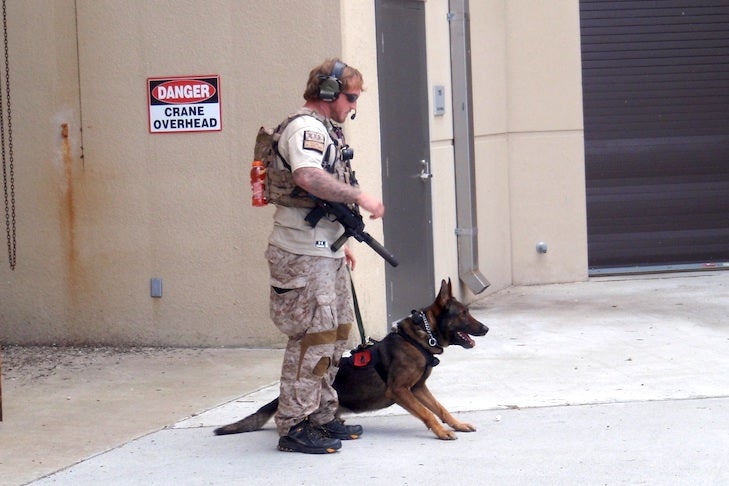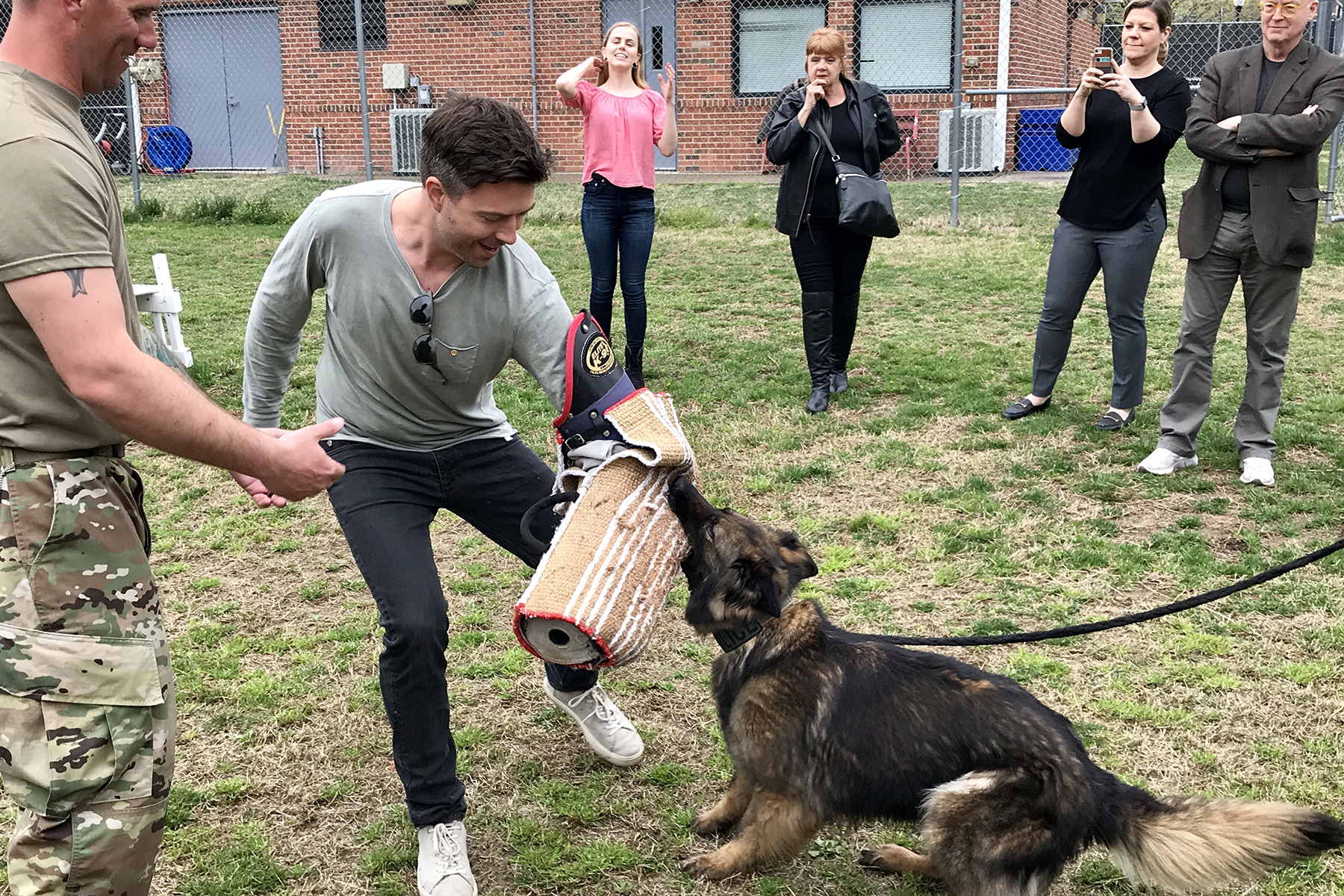Ready for the Workforce Workforce
Whether they have Puppy Program pedigrees or outside credentials, would-be canine troops have to graduate from the Military Working Dog Training Program to enter regular military service.
Most dogs that successfully complete the 120-day program qualify to be dual-purpose dogs that either patrol and sniff out explosives or patrol and detect drugs. Its also at San Antonio, and also run by the 341st Training Squadron, which has been training dogs at the base since the 1950s.
Once dogs graduate from training in San Antonio, they go to work for one of the services. The dogs usually stay with their assigned service throughout their careers, just like their human comrades.
Dogs like Benny, at the Air Forces 673rd Security Forces Squadron, have a couple of weeks to build rapport with their handlers when they arrive from San Antonio, and then its training, training, training. Bennys handler explains what they do, why they do it and what its like to have a coworker who chomps on his arm on a regular basis.
Just as dogs need training in their specific job skills, like sniffing out bombs or catching bad guys, they also need training to get used to the sounds, sights and sensations they could encounter at work. For Coast Guard Petty Officer 1st Class James Grant, that means getting his partner, Sonya, used to the wind, noise and motion of being hoisted into a helicopter high above the ground.
The jobs that military working dogs do are both risky and physically demanding. Training keeps them in tip-top shape, but the military also makes sure they have state-of-the-art medical care when they need it. The Lt. Col. Daniel E. Holland Military Working Dog Hospital in San Antonio is the Defense Departments premier veterinary hospital, serving all military working dogs globally.
With any job, there are primary responsibilities and the extra stuff you get asked to do from time to time. If a VIP is visiting your workplace, for instance, you might have to help out with the dog and pony show. And so do dogs – just without the ponies.
While most people are familiar with military working dogs, this one is a special type of dog called a Multi-Purpose Canine.
They are the special forces of military working dogs, attached to special operations forces, such as the Navy SEALS and Army Rangers. Trained to find explosives, chase down human targets, and detect hidden threats, these Multi-Purpose Canines, or MPCs, are also trained to rappel out of helicopters, parachute out of airplanes, and conduct amphibious operations on Zodiac boats. Highly skilled, an MPC named Cairo even assisted in the raid that killed Osama bin Laden in 2011.
These dogs are specially selected and trained to handle the most stressful situations while keeping their cool. In the spirit of the Marine Recon motto, these dogs are swift, silent, and deadly. Barking is forbidden. With the secretive nature of their work, much of the information regarding the selection and training of these dogs is classified.
Military Working Dogs: Facts & Figures

The Warfighters: A Soldier’s Best Friend (S1, E12) | Full Episode
Since the time of Greece and the Roman Empire, the dog has been a valued and trusted member of the military. The Romans used a breed of Mastiff that is now extinct. Then, they covered their canines in armor with spiked collars and used them to wreak havoc on their enemies.
The use of military dogs by the United States was largely an unknown to the general population until a Belgian Malinois named “Cairo” was thrust into the spotlight after the raid that killed Osama bin Laden in Pakistan by US Navy SEALs.
But the use of military dogs goes far back from the wars in Afghanistan and Iraq. The first well-known military dog was SGT Stubby who was a stray Bull Terrier that was adopted by the 102nd Infantry Regiment of the 26th Infantry Division (The Yankee Division).
Stubby was smuggled on the troop ship to France but quickly proved his worth. He could warn the troops of impending poison gas attacks, could hear artillery shells coming before human ears could detect them, he could find American wounded in no man’s land and even caught a German prisoner, grabbing the enemy by the seat of his pants and holding him until the soldiers made him a prisoner.
Stubby met three US Presidents, marched in numerous parades and even received a half-page obituary in the New York Times when he died in his sleep in 1926. But dogs have been used in every conflict since the Revolutionary War, but only officially used since World War II.
Today the training and use of military dogs are extensive and there are a few thousand serving in the armed forces. Many of them are in harm’s way in the conflicts in Iraq, Afghanistan, and Syria, among other hotspots and they’ve proved invaluable.
America’s military dogs can find illicit drugs, sniff out bombs and IEDs (improvised explosive devices), search out and find enemy combatants. They’re almost all trained at the Joint Base San Antonio-Lackland as part of the Department of Defense Military Working Dog Program (MWD). The military has been training their canines there since 1958.
German shepherds and retrievers are commonly used, but the Belgian Malinois (i.e.Cairo) has proven to be one of the most outstanding working dogs used in military service. The vast majority of military working dogs are purchased in Germany or the Netherlands, where they have been breeding dogs for military purposes for hundreds of years. But because of the uptick in operational tempo as well as the demand, the breeding programs in the United States are flourishing.
The dogs must exhibit focused, aggressive behavior, with a heightened sense of smell and a strong desire to work for reward before they are assigned to operators worldwide.
Typically, pups begin their training very early. When they’re very young, (6-8 weeks of age), they’re sent to homes for socialization skills in a stable, home setting. They’ll come back to the school between 7-9 months where they’ll be observed for consideration as a working dog. The puppies must exhibit a strong drive, are adaptable to a host of different environments and respond to reward-for-work motivation before they can begin the pre-training program.
The training is long and difficult and only 50 percent of the dogs pass thru their dog school “Selection.” After the dogs are a year-old and pass their advanced training, they’ll have two primary roles. Either as an operator in search for explosives or narcotics detection or as patrol member for apprehension and search for the enemy.
Malinois’ are favored because of their agility, speed, focused aggressive behavior and the fact that their sense of smell is 40 times that of their human handlers. Military dogs frequently are used in airborne operations, rappelling, and helo-casting.
Dogs that work with Special Operations units are specifically trained in just a handful of locations. CBS’ Lara Logan did a story on former Navy SEAL Mike Ritland who trains dogs for the dangerous world of Special Operations as well as for the FBI and SWAT teams.
In the same story, Logan did a story on Chris Corbin from the 7th Special Forces Group and his dog Ax. They both almost lost their lives on the same day in Afghanistan on their final mission. Ax had already found one bomb and the two were moving toward an area that had already been cleared.
Corbin missed Ax’s signal, thinking he was just smelling another dog in the cleared area when the bomb went off. Ax was shaken but ok, Corbin lost both of his lower legs. But a few months later he was back on active duty…with Ax and the two grew inseparable.
Corbin told Logan that the bond was there when his teammates brought Ax to see him at Walter Reed Army Hospital. “They brought him up for a visit. And I heard him, getting him out of the back of the truck. And opening his kennel, and he just being a stir-crazy dog, just, ‘Hey, let me out of here. Let’s do a look around.’ I just said something simple. Hey, where’s my boy at? and he stopped. He froze. He looked around. And he went into a panic until he found me and he jumped on my legs. Painful. Just– I was just happy to see him. I didn’t care how much it hurt.”
Some dogs, like their human counterparts, can suffer from the throes of PTSD. Many of the dogs are treated for such and return to have successful completions to their military careers. When one of these canine operators is wounded, they’re transported via medevac just like a wounded soldier would.
Sadly 42 dogs have paid the ultimate sacrifice for our country and their handlers. But a good indicator of their worth is how the enemy feels about them. The Taliban and ISIS hate the military working dogs and have a healthy respect for them. The Taliban soldiers have orders to shoot the dogs first and American soldiers second.
The unfortunate footnote to this story is that prior to November 2000, military working dogs were euthanized upon the finish of their career. Now, most are adopted by their handlers. A few each year go to civilians who apply for adoption rights. The waiting list for an adoptable military working dog is about a year.
Our military forces continue to keep us safe, at home and abroad. And their four-legged counterparts are doing their share as well. And SGT Stubby? He’s being immortalized in an upcoming animated feature film that is being released in 2018.
Praesidus brings homage to the military watch tradition. With robust designs and vintage classic style, discover the heritage of military timepieces today!
USAA proudly serves millions of military members and their families with competitive rates on insurance, banking and investment services.
Fox Nation is an entertainment streaming service brought to you by FOX News. Stream exclusive shows, documentaries, and news stories that celebrate America.
